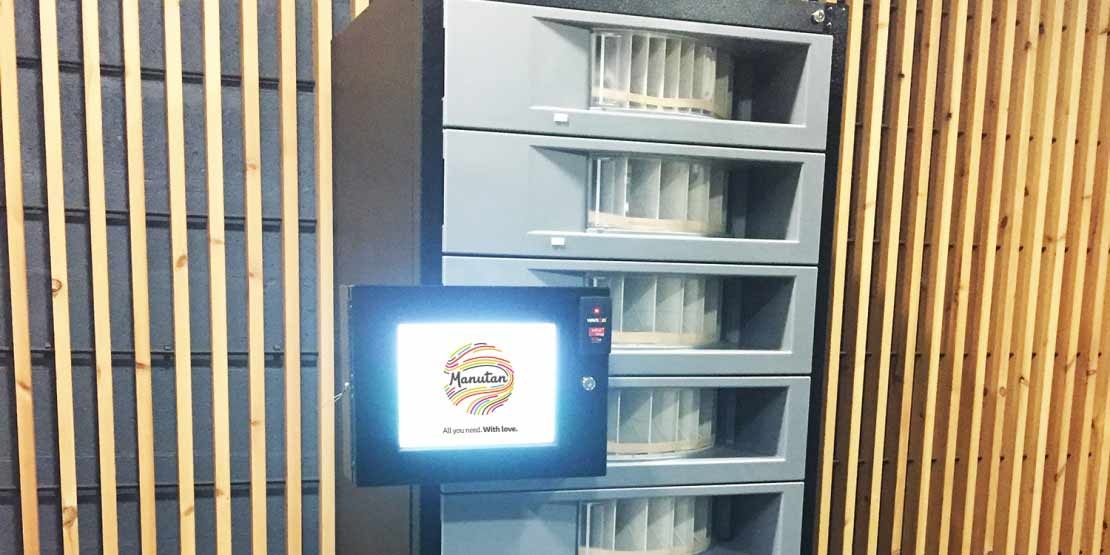When we calculate the costs of a transaction we rarely include the costs involved in making the purchased products available to the end users. And yet this is a valuable cost-saving lever for indirect or “non-strategic” purchases, which represent a large number of transactions and deliveries (only 15% of purchases, but 50% of orders) for often very small purchase amounts. Automatic vending machines are a very effective solution for reducing these costs.
Goal: diminish the costs of making products available
These costs are due mainly to:
- The expenses involved in receiving packages, orienting delivery drivers, enabling delivery trucks to enter the site safely, etc.;
- Storing the delivered products and organising their distribution to the end users;
- The time required for users to collect the products they ordered or which they need.
Manutan proposes several options for cutting these costs:
- Grouping orders to reduce transport costs, as well as the costs of dealing with delivery trucks and receiving packages;
- Delivery at regular intervals (weekly, for example, at fixed days and times), thereby optimising the distribution of products to the end users. This solution makes deliveries predictable, freeing up time for the personnel in charge of reception. It is also a way to develop sound habits among users, so that they are not left waiting for deliveries during the week;
- Finally, making products available from vending machines. In this area, there are a number of solutions to facilitate user access to products while at the same time reducing the rate of consumption.
How the vending machine solution works
Vending machines can make numerous products available round the clock alongside the user workstation. After authenticating with the company badge, the user chooses a product by clicking on the corresponding image or description and picks it up from the slot of the machine.
Meanwhile, the management software records each transaction as it is made in order to issue a weekly replenishment order or—if the machine stock reaches the pre-defined alert level—an immediate order.
What sorts of products are generally dispensed in vending machines?
Inside the vending machines we find, of course, all kinds of consumables and personal protective equipment (PPE). But the machines can also be used for other areas of application such as bolts and screws, etc. (in machines with load weighing units), cutting tools or abrasives, critical spare parts (e.g., bearings, fuses, etc.) or indeed for tools that are easily lost or stolen.
Customer benefits
In addition to simplifying access to products, automatic vending machines can optimise the entire product receiving and distribution process. The main beneficiaries of such a project are:
- Purchasing, through the observed reduction of 20% to 40% in product consumption by optimising product utilisation rates, but also through the introduction of automatic orders generated by the machines. And if too much of a product is drawn down, the machines can send out an alert for urgent resupply;
- Production, by reducing the time workers spend waiting for, or collecting, the products they need, as a result of installing the machines next to the workstations. The machines also ensure product availability 24/7/365*;
- Health & Safety, and Security, by ensuring that each worker has access to the right products. The machines can be programmed to dispense the appropriate products for each workstation, depending on the badge used. This helps to avoid errors and, consequently, accidents;
- Inventory Management, by reducing the order management and replenishment workload (no manual orders means fewer errors). Deliveries can also be optimised by grouping orders for other products with those for the machines.
Installing a vending machine: the 3 key steps
- It all begins with a preparation phase, to clearly define the expected objectives of installing the machines: reduced consumption, improved safety, enhanced productivity. Once the objectives have been finalised, KPIs are identified and the profitability of the project is assessed.
- The second step is about the selection, configuration and implementation of the machines on the basis of the products to be distributed, the estimated consumption, and the geography of the sites. This study phase will identify the most suitable types of machine (carrousel, locker, load-measuring, tool drawers, etc.), and define their configuration (number and size of cells, etc.) and their location at the site. It then remains to configure the system and access: users, badges, product sheets, and automatic order flows.
- The final step concerns the machine replenishment solution, defining its frequency and organisation: delivery process, access, times, etc.
Optimising the process of receiving products and making them available to the end users generates significant savings on the total cost of acquisition of a product. The most effective way to optimise this process is by introducing weekly deliveries and vending machines. To take it still further, other optimisation solutions—such as “shop in shop” systems and Vendor Managed Inventory (VMI)—are also available.
*24 hours a day, 7 days a week, 365 days a year









